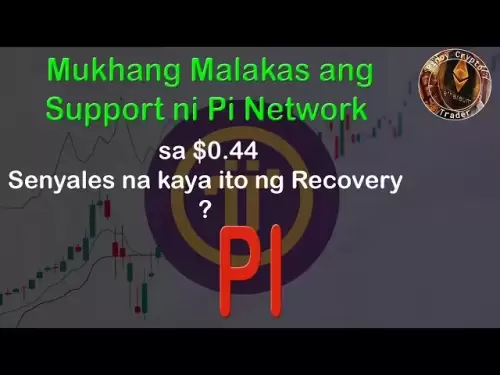-
 Bitcoin
Bitcoin $108,708.8110
0.60% -
 Ethereum
Ethereum $2,561.6057
1.91% -
 Tether USDt
Tether USDt $1.0001
-0.03% -
 XRP
XRP $2.2795
0.57% -
 BNB
BNB $662.2393
1.00% -
 Solana
Solana $153.1346
3.74% -
 USDC
USDC $1.0000
0.00% -
 TRON
TRON $0.2877
0.97% -
 Dogecoin
Dogecoin $0.1710
3.93% -
 Cardano
Cardano $0.5871
1.61% -
 Hyperliquid
Hyperliquid $39.6663
1.68% -
 Sui
Sui $2.9032
0.79% -
 Bitcoin Cash
Bitcoin Cash $496.1879
1.71% -
 Chainlink
Chainlink $13.5807
3.01% -
 UNUS SED LEO
UNUS SED LEO $9.0777
0.61% -
 Stellar
Stellar $0.2514
4.51% -
 Avalanche
Avalanche $18.1761
1.86% -
 Shiba Inu
Shiba Inu $0.0...01173
1.72% -
 Toncoin
Toncoin $2.8010
-4.23% -
 Hedera
Hedera $0.1594
3.21% -
 Litecoin
Litecoin $87.0257
-0.53% -
 Monero
Monero $319.1217
1.79% -
 Polkadot
Polkadot $3.3853
0.68% -
 Dai
Dai $0.9999
-0.01% -
 Ethena USDe
Ethena USDe $1.0003
0.02% -
 Bitget Token
Bitget Token $4.3420
-0.97% -
 Uniswap
Uniswap $7.3772
1.39% -
 Aave
Aave $286.6277
5.61% -
 Pepe
Pepe $0.0...09994
2.33% -
 Pi
Pi $0.4589
1.76%
Must APT be sold immediately after the MACD cross appears?
Before selling APT after a MACD cross, consider market context, volume, other indicators, and time frame to make an informed decision.
Apr 24, 2025 at 07:43 pm
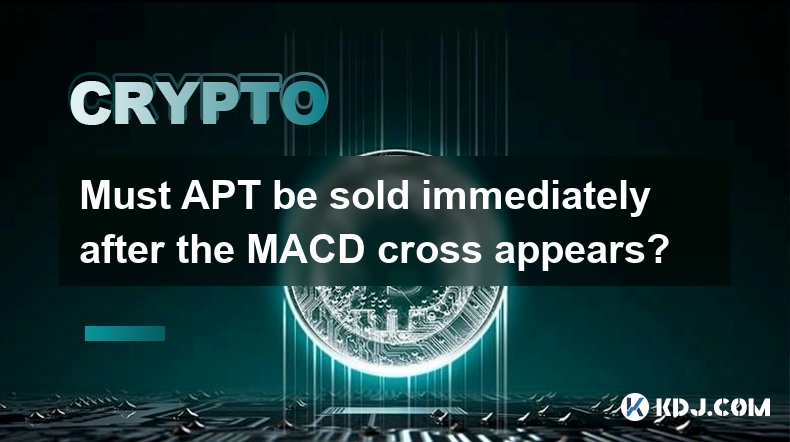
The question of whether APT (Aptos) should be sold immediately after a MACD (Moving Average Convergence Divergence) cross appears is a common one among traders. The MACD is a popular technical indicator used to identify potential buy and sell signals in the cryptocurrency market. However, the decision to sell APT immediately after a MACD cross is not straightforward and depends on various factors. In this article, we will explore the intricacies of the MACD indicator, its application to APT, and the considerations traders should keep in mind before making a decision.
Understanding the MACD Indicator
The MACD is a momentum indicator that shows the relationship between two moving averages of a cryptocurrency's price. It consists of the MACD line, the signal line, and the histogram. The MACD line is calculated by subtracting the 26-period exponential moving average (EMA) from the 12-period EMA. The signal line is a 9-period EMA of the MACD line. A MACD cross occurs when the MACD line crosses above or below the signal line, which is often interpreted as a buy or sell signal, respectively.
The Significance of a MACD Cross
A MACD cross is significant because it can indicate a potential change in the momentum of APT's price. When the MACD line crosses above the signal line, it is considered a bullish signal, suggesting that it might be a good time to buy. Conversely, when the MACD line crosses below the signal line, it is considered a bearish signal, suggesting that it might be a good time to sell. However, relying solely on a MACD cross to make trading decisions can be risky.
Factors to Consider Before Selling APT
Before deciding to sell APT immediately after a MACD cross, traders should consider several factors:
- Market Context: The overall market trend and sentiment can influence the effectiveness of a MACD cross. If the broader market is bullish, a bearish MACD cross might not be as significant.
- Volume: High trading volume accompanying a MACD cross can validate the signal. Low volume might indicate a false signal.
- Other Indicators: Using additional technical indicators, such as the Relative Strength Index (RSI) or Bollinger Bands, can provide a more comprehensive view of APT's price movement.
- Time Frame: The time frame on which the MACD cross occurs can affect its reliability. A cross on a longer time frame (e.g., daily chart) might be more significant than one on a shorter time frame (e.g., hourly chart).
Analyzing APT's Price Movement
To make an informed decision about selling APT after a MACD cross, traders should analyze the cryptocurrency's price movement in detail. Here are some steps to follow:
- Identify the MACD Cross: Look for the point where the MACD line crosses below the signal line on the chart.
- Check the Histogram: The histogram can provide additional insights into the strength of the momentum shift. A widening histogram indicates increasing momentum.
- Review Historical Data: Examine past instances of MACD crosses for APT to see how the price reacted. This can help gauge the reliability of the signal.
- Consider the Price Action: Look at the candlestick patterns and price levels around the MACD cross. Support and resistance levels can influence the decision to sell.
Using Additional Technical Indicators
While the MACD is a powerful tool, it is often more effective when used in conjunction with other technical indicators. Here are some additional indicators that can help traders make a more informed decision about selling APT:
- Relative Strength Index (RSI): The RSI measures the speed and change of price movements. An RSI above 70 indicates overbought conditions, while an RSI below 30 indicates oversold conditions. If the RSI is overbought and a bearish MACD cross occurs, it might be a stronger signal to sell.
- Bollinger Bands: These bands can help identify volatility and potential price breakouts. If APT's price is touching the upper Bollinger Band and a bearish MACD cross occurs, it could indicate a potential reversal.
- Moving Averages: Simple or exponential moving averages can help confirm the trend. If APT's price is below a key moving average and a bearish MACD cross occurs, it might reinforce the sell signal.
Implementing a Trading Strategy
Developing a trading strategy that incorporates the MACD cross and other factors can help traders make more informed decisions about selling APT. Here are some steps to create a strategy:
- Define Entry and Exit Points: Determine the specific conditions under which you will enter and exit a trade based on the MACD cross and other indicators.
- Set Stop-Loss and Take-Profit Levels: Establish stop-loss orders to limit potential losses and take-profit orders to secure gains.
- Backtest the Strategy: Use historical data to test the strategy and see how it would have performed in the past.
- Monitor and Adjust: Continuously monitor the market and adjust the strategy as needed based on new information and market conditions.
Practical Example of Using MACD for APT
Let's walk through a practical example of how a trader might use the MACD to decide whether to sell APT:
- Identify the MACD Cross: Suppose a bearish MACD cross occurs on the daily chart for APT, with the MACD line crossing below the signal line.
- Check the Histogram: The histogram is widening, indicating increasing bearish momentum.
- Review Historical Data: Historical data shows that similar MACD crosses have led to significant price declines in the past.
- Consider the Price Action: APT's price is approaching a key support level, and the candlestick pattern suggests a potential reversal.
- Use Additional Indicators: The RSI is overbought at 75, and APT's price is touching the upper Bollinger Band.
- Implement the Strategy: Based on these factors, the trader decides to sell APT, setting a stop-loss just above the recent high and a take-profit at the next significant support level.
Frequently Asked Questions
Q: Can the MACD cross be used as the sole indicator for selling APT?
A: While the MACD cross can provide valuable insights, it is generally not recommended to use it as the sole indicator for making trading decisions. Combining the MACD with other technical indicators and considering market context can lead to more reliable signals.
Q: How often should I check for MACD crosses on APT?
A: The frequency of checking for MACD crosses depends on your trading style. Day traders might check hourly or even minute charts, while swing traders might focus on daily or weekly charts. It's important to align the time frame with your trading strategy.
Q: What should I do if a MACD cross occurs but the volume is low?
A: Low volume accompanying a MACD cross can indicate a false signal. In such cases, it's advisable to wait for confirmation from other indicators or a subsequent increase in volume before making a trading decision.
Q: Is it possible for a MACD cross to be a false signal?
A: Yes, MACD crosses can sometimes be false signals, especially in choppy or sideways markets. It's crucial to use additional analysis and indicators to confirm the validity of the signal before acting on it.
Disclaimer:info@kdj.com
The information provided is not trading advice. kdj.com does not assume any responsibility for any investments made based on the information provided in this article. Cryptocurrencies are highly volatile and it is highly recommended that you invest with caution after thorough research!
If you believe that the content used on this website infringes your copyright, please contact us immediately (info@kdj.com) and we will delete it promptly.
- Bitcoin Mempool at Historical Lows: Trouble on the Horizon?
- 2025-07-07 21:10:12
- CleanSpark Dominates Bitcoin Mining: 50 EH/s and Beyond
- 2025-07-07 21:50:12
- BitFuFu's Bitcoin Mining Momentum: Hashrate Expansion and Market Dynamics in 2025
- 2025-07-07 21:15:12
- Pi Network's Studio Upgrade: Building the Web3 App Store, One Pioneer at a Time
- 2025-07-07 21:50:12
- Jorhat's Jora Villa: A Coin-Curated Chronicle of Assam's History and Heritage
- 2025-07-07 21:55:12
- Dubai's Cashless Conquest: How Know-How Fuels the Future
- 2025-07-07 21:55:12
Related knowledge
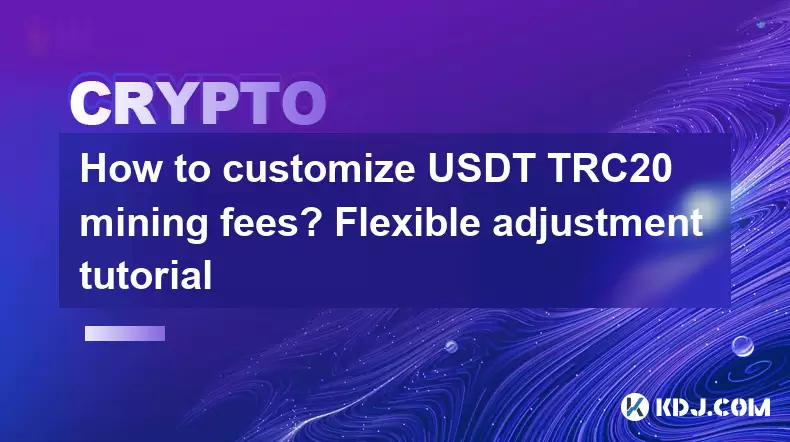
How to customize USDT TRC20 mining fees? Flexible adjustment tutorial
Jun 13,2025 at 01:42am
Understanding USDT TRC20 Mining FeesMining fees on the TRON (TRC20) network are essential for processing transactions. Unlike Bitcoin or Ethereum, where miners directly validate transactions, TRON uses a delegated proof-of-stake (DPoS) mechanism. However, users still need to pay bandwidth and energy fees, which are collectively referred to as 'mining fe...
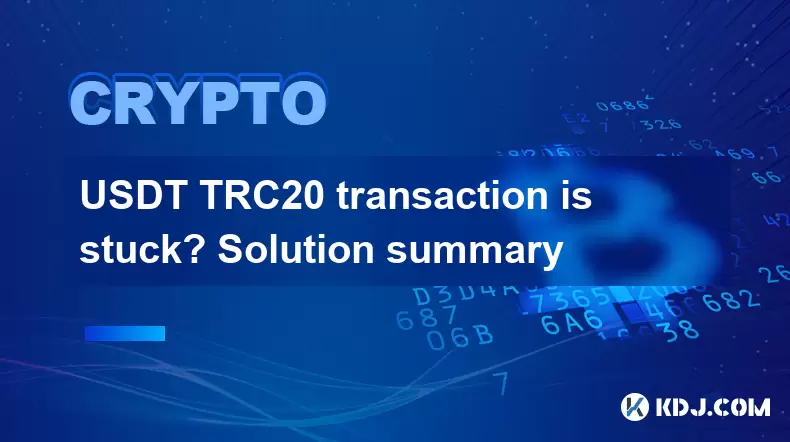
USDT TRC20 transaction is stuck? Solution summary
Jun 14,2025 at 11:15pm
Understanding USDT TRC20 TransactionsWhen users mention that a USDT TRC20 transaction is stuck, they typically refer to a situation where the transfer of Tether (USDT) on the TRON blockchain has not been confirmed for an extended period. This issue may arise due to various reasons such as network congestion, insufficient transaction fees, or wallet-rela...
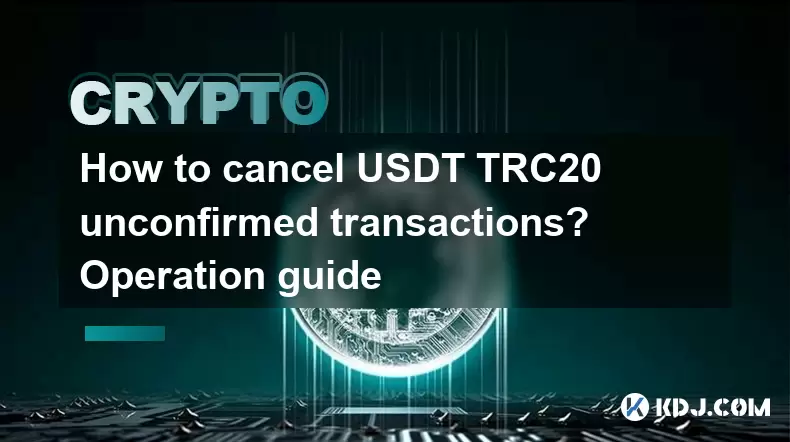
How to cancel USDT TRC20 unconfirmed transactions? Operation guide
Jun 13,2025 at 11:01pm
Understanding USDT TRC20 Unconfirmed TransactionsWhen dealing with USDT TRC20 transactions, it’s crucial to understand what an unconfirmed transaction means. An unconfirmed transaction is one that has been broadcasted to the blockchain network but hasn’t yet been included in a block. This typically occurs due to low transaction fees or network congestio...
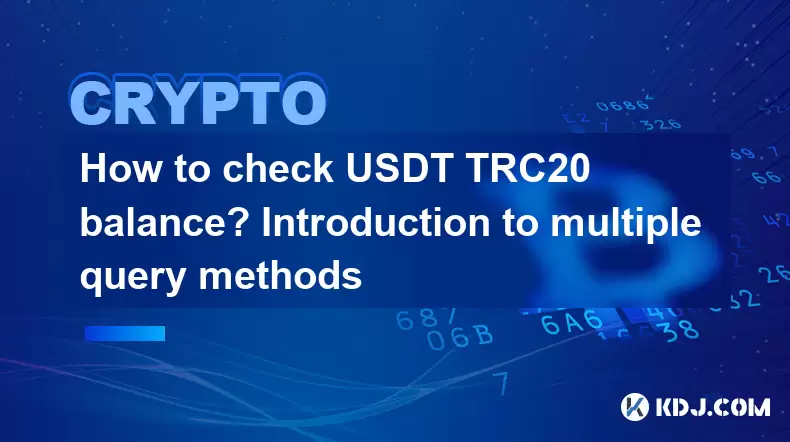
How to check USDT TRC20 balance? Introduction to multiple query methods
Jun 21,2025 at 02:42am
Understanding USDT TRC20 and Its ImportanceUSDT (Tether) is one of the most widely used stablecoins in the cryptocurrency market. It exists on multiple blockchain networks, including TRC20, which operates on the Tron (TRX) network. Checking your USDT TRC20 balance accurately is crucial for users who hold or transact with this asset. Whether you're sendi...
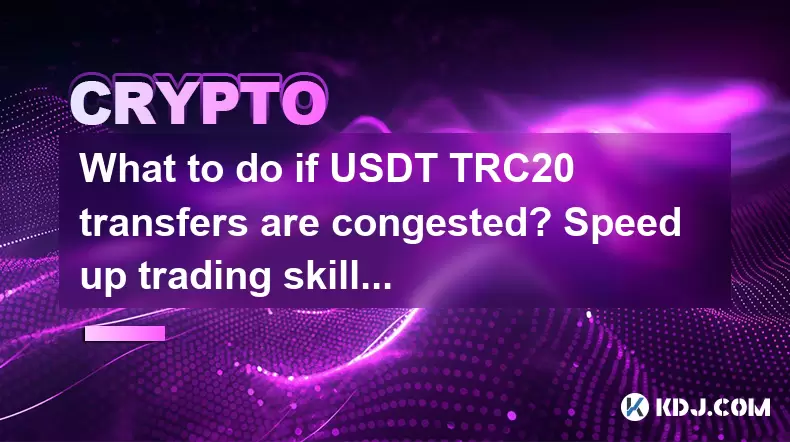
What to do if USDT TRC20 transfers are congested? Speed up trading skills
Jun 13,2025 at 09:56am
Understanding USDT TRC20 Transfer CongestionWhen transferring USDT TRC20, users may occasionally experience delays or congestion. This typically occurs due to network overload on the TRON blockchain, which hosts the TRC20 version of Tether. Unlike the ERC20 variant (which runs on Ethereum), TRC20 transactions are generally faster and cheaper, but during...
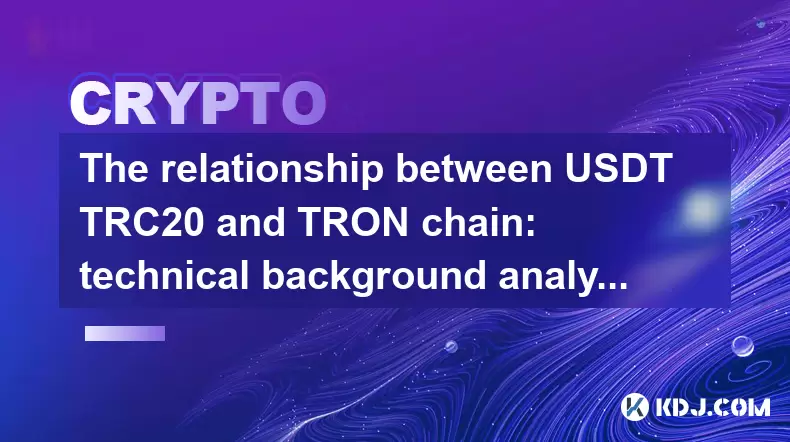
The relationship between USDT TRC20 and TRON chain: technical background analysis
Jun 12,2025 at 01:28pm
What is USDT TRC20?USDT TRC20 refers to the Tether (USDT) token issued on the TRON blockchain using the TRC-20 standard. Unlike the more commonly known ERC-20 version of USDT (which runs on Ethereum), the TRC-20 variant leverages the TRON network's infrastructure for faster and cheaper transactions. The emergence of this version came as part of Tether’s...

How to customize USDT TRC20 mining fees? Flexible adjustment tutorial
Jun 13,2025 at 01:42am
Understanding USDT TRC20 Mining FeesMining fees on the TRON (TRC20) network are essential for processing transactions. Unlike Bitcoin or Ethereum, where miners directly validate transactions, TRON uses a delegated proof-of-stake (DPoS) mechanism. However, users still need to pay bandwidth and energy fees, which are collectively referred to as 'mining fe...

USDT TRC20 transaction is stuck? Solution summary
Jun 14,2025 at 11:15pm
Understanding USDT TRC20 TransactionsWhen users mention that a USDT TRC20 transaction is stuck, they typically refer to a situation where the transfer of Tether (USDT) on the TRON blockchain has not been confirmed for an extended period. This issue may arise due to various reasons such as network congestion, insufficient transaction fees, or wallet-rela...

How to cancel USDT TRC20 unconfirmed transactions? Operation guide
Jun 13,2025 at 11:01pm
Understanding USDT TRC20 Unconfirmed TransactionsWhen dealing with USDT TRC20 transactions, it’s crucial to understand what an unconfirmed transaction means. An unconfirmed transaction is one that has been broadcasted to the blockchain network but hasn’t yet been included in a block. This typically occurs due to low transaction fees or network congestio...

How to check USDT TRC20 balance? Introduction to multiple query methods
Jun 21,2025 at 02:42am
Understanding USDT TRC20 and Its ImportanceUSDT (Tether) is one of the most widely used stablecoins in the cryptocurrency market. It exists on multiple blockchain networks, including TRC20, which operates on the Tron (TRX) network. Checking your USDT TRC20 balance accurately is crucial for users who hold or transact with this asset. Whether you're sendi...

What to do if USDT TRC20 transfers are congested? Speed up trading skills
Jun 13,2025 at 09:56am
Understanding USDT TRC20 Transfer CongestionWhen transferring USDT TRC20, users may occasionally experience delays or congestion. This typically occurs due to network overload on the TRON blockchain, which hosts the TRC20 version of Tether. Unlike the ERC20 variant (which runs on Ethereum), TRC20 transactions are generally faster and cheaper, but during...

The relationship between USDT TRC20 and TRON chain: technical background analysis
Jun 12,2025 at 01:28pm
What is USDT TRC20?USDT TRC20 refers to the Tether (USDT) token issued on the TRON blockchain using the TRC-20 standard. Unlike the more commonly known ERC-20 version of USDT (which runs on Ethereum), the TRC-20 variant leverages the TRON network's infrastructure for faster and cheaper transactions. The emergence of this version came as part of Tether’s...
See all articles























